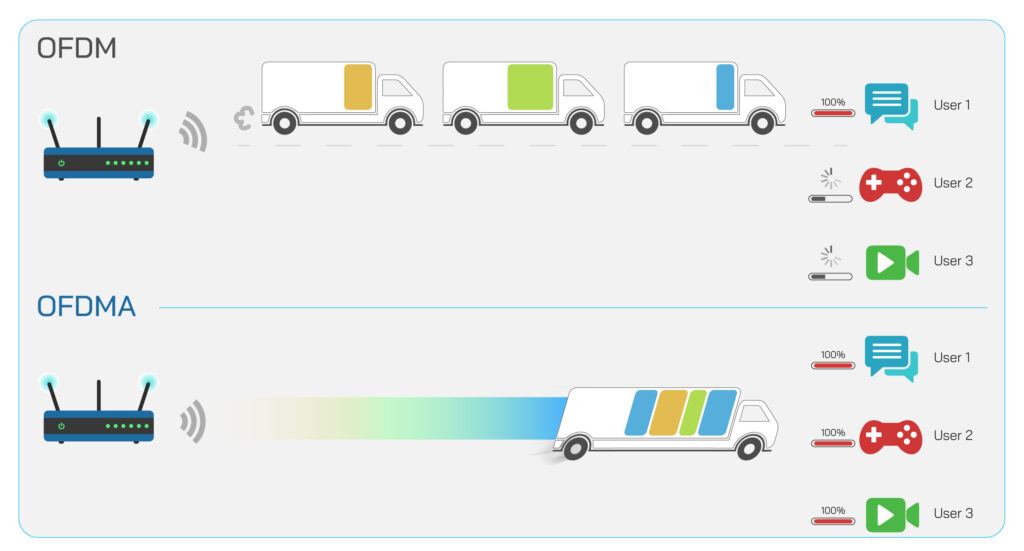
Background
With everything connected to the high-speed network, we not only achieve real-time processing for diverse applications at edge, but also complete prompt response directly executed by intelligent machines. As the fundamental of AIoT and Edge AI, the higher speed internet is benefited from 5G and Wi-Fi 6. We have been talking about 5G in our previous Tech Blogs and we will have a closer look at Wi-Fi 6 here.
What is Wi-Fi
Wi-Fi is a trademark representing a group of wireless networking protocols based on the IEEE 802.11 network standard. We may also see other expressions such as WiFi or Wifi which is not recognized by Wi-Fi Alliance, a non-profit organization to brand products certified for Wi-Fi interoperability.
Since 1997, the very first IEEE 802.11 technology is announced, alphabets such as a/b/g/n were applied as suffix of 802.11 to stand for different versions of the wireless network. As newer technology has been pushing out in a short period of time, more and more letters make the expression become complex and hard to tell the difference at first glance based on the full name.
To keep it clear and simple, Wi-Fi Alliance use numbers to re-name Wi-Fi. The latest version of this technology, 802.11ax, is called Wi-Fi 6. It is the improved standard based on 802.11ac Wi-Fi, Wi-Fi 5. It also defined 802.11n as Wi-Fi 4, etc.
| Generation/IEEE Standard |
Frequency |
Maximum Link Rate |
Year |
| Wi-Fi 6 (802.11ax) |
2.4/5 GHz |
600-9608 Mbit/s |
2019 |
| Wi-Fi 5 (802.11ac) |
5 GHz |
433-6933Mbit/s |
2014 |
| Wi-Fi 4 (802.11n) |
2.4/5 GHz |
72-600 Mbit/s |
2009 |
Advantage of Wi-Fi 6
Faster
Better upload and download speeds (or throughput) had been accomplish with 1024-QAM and the increased bandwidth afforded by Wi-Fi 6. With 1024-QAM, more information can be transmitted within one signal (10bits compared to previous 8bits). Along with wider bandwidth of 160 MHz doubling the bandwidth, Wi-Fi 6 can provide faster network for the up-to-date demands for a variety of applications.
Higher Efficiency
Wi-Fi 6 has OFDMA which can enhance the utilization of the internet and lower the latency of connection by dividing the frequency into divisions for multiple access. With the subcarriers, diverse devices can transmit data at the same time to improve network performance. Below is the illustration, imaging the Wi-Fi connection as a truck fleet to carry packages to devices. With OFDMA, each truck can transport various packages to different terminals simultaneously to benefit both upload and download of the transmission.

Network Security
Wi-Fi 6 with WPA3 (Wi-Fi Protected Access 3) support higher level of security. Replacing WPA-PSK (Pre-Shared Key) with SAE (Simultaneous Authentication of Equals), WPA3 creates a safer internet connection by making passwords harder to crack. Coupled with stronger encryption, FS (Forward Secrecy), and PMF (Protected Management Frames), Wi-Fi 6 offers more robust security than ever.
More Possibilities with Wi-Fi 6
Wi-Fi 6 as a local area network is just right to coexist with 5G mobile network for the faster wireless communication. Together with 5G and Wi-Fi 6, AEWIN ultra-compact system act as uCPE to provide the performant network (wireless and wire) along with rich I/O for smart control and strengthen security with the best reliability to fulfill and develop high-speed related applications in AIoT and Edge AI for vast industries. To know more, please don’t hesitate to contact AEWIN friendly sales!
– SCB-6989: Denverton Platform with 8x GbE ports, 3x mini-PCIe for 5G/Wi-Fi 6, and QAT.
– SCB-6995: Denverton Refresh Platform with 6x GbE ports, 2x SFP+, 1x mini-PCIe & 1x M.2 for 5G/Wi-Fi 6, and QAT.
– SCB-6913: Elkhart Lake Platform with 6x RJ45 GbE ports and 3x M.2 (w/ 4x SIM) for 5G/Wi-Fi 6.